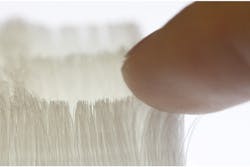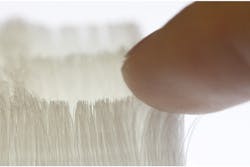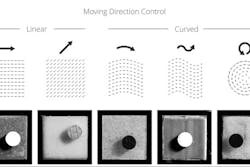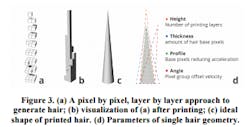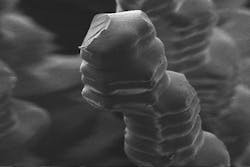Surface-Texture Cilia 3D-Printed to 50-Micron Resolution
MIT’s Tangible Media Group presents intuitive software that enables 3D-printing of complex textures that are otherwise unachievable with computer-aided design (CAD) tools.
Designed for commercially available high-resolution 3D printers, the software’s graphical user interface lets users customize the thickness, shape, height, angle, and rigidity of individual grain structures—coined Cilllia by the researchers. The software may also be used to define overall grain patterns and periodic variations in Cilllia height and density across a surface. The team has been able to use the software to generate dense-hair structures with Cilllia thicknesses ranging from 150 to 50 microns—about half the diameter of an average human hair and a speck of dust.
published by researchers from MIT Media Lab, MIT Architechture, and Addimation Inc. discusses structures that can be used for controlled actuation, Velcro-like adhesion, and motion sensing across flat or curved surfaces. The team predicts that 3D-printed Cilllia will provide customized functionality for optical, mechanical, electrical, and biological applications at reduced production cost and time to market.
Below are some preliminary applications presented in the paper.
1. By exposing Cilllia grain surfaces to pulse vibrations, a user can create a controlled sense of motion for actuation of an object across a surface.
2. Cilllia may be used in acoustic sensors that measure the direction and speed of an object as it moves across the surface. Acoustic sensing usually consists of fiber optic cables that see variations in their indexes of refraction as they bend in response to strain. This causes variations in light pulses that are measured by an optoelectric tool.
3. Cilllia surfaces may also be used for sorting items by weight, based on their reaction to different vibrational frequencies.
3D printing
For the 3D printing, the team used an Autodesk Ember Printer. The digital-light-processing (DLP) 3D printer deposits a liquid photopolymer that hardens when exposed to UV light (this is a stereolithography technique). The printer has a resolution of 50 µm on the X and Y axes, and 25 µm on the Z axis.
Bitmap and Pixel-Layer Software Strategy
The team did not rely on CAD models to produce the individual cilia with various heights, thicknesses, angles, and profiles (which are cited in the paper to generate mere illusions of complicated textures by importing bitmap layer information to the printer). Instead, to achieve individual and accurate conical representations of cilia, the team created software that would provide information to Ember pixel-by-pixel. However, they did use colored-coded bitmaps to define variations in height, grain direction, and density of the hairs.
For more information about the software and applications of Cilllia, and how to print on uneven surfaces, read the paper Cilllia - 3D Printed Micro-Pillar Structures for Surface Texture, Actuation and Sensing, published by the Tangible Media Group.
GIFs in this article are created via Giphy from the Tangible Media Group's full video on Vimeo, shown below.
About the Author
Leah Scully
Associate Content Producer
Leah Scully is a graduate of The College of New Jersey. She has a BS degree in Biomedical Engineering with a mechanical specialization. Leah is responsible for Machine Design’s news items that cover industry trends, research, and applied science and engineering, along with product galleries. Visit her on Facebook, or view her profile on LinkedIn.
